Urdu Language

 Introduction
IntroductionSultan Mahmud of the Ghaznavid empire conquered Punjab of the Indian subcontinent in the early 11th century. the Ghurids invaded northern India in the 12th century. The invasions of the subcontinent by the Persian and Turkic dynasties paved way for the establishment of the Delhi Sultanate. Following the Mughal conquest of South Asia and the establishment of vast Islamic empire, especially in the northern and central regions of the South Asia, a hybrid language of Arabic, Pashto, Turkish, Persian, and local dialects began to form around the 16th and 17th centuries CE mainly for use as a communication tool between the soldiers of Persian, Arab, or Turkish descent.
This language eventually came to be known as Urdu (from a Turkish word meaning "army", in allusion to the army barracks of visiting troops). Persian was crucial in the formation of Urdu. Urdu vocabulary contains approximately 70% Farsi and the rest being a mix of Arabic and Turkish. However, there are also traces of the French, Portuguese and Dutch language in Urdu. The grammar takes some elements from Farsi and Arabic but also has elements that are unique and different from all three of its mother tongues.
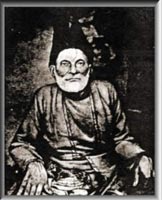 Urdu belongs to the Indo-Aryan family of languages. Urdu by origin is considered to be a descendent of Saur Senic Prakrit. As Prakrit language began to develop, it was influenced by Western Hindi dialects of Khari Boli, Brij Bhasa and Haryanvi. A need was felt to differentiate Urdu from other languages especially Hindi which later became a Hindi-Urdu controversy. As a result Khari Boli and Devanagari became the identity of Indians while Urdu and Persian that of Muslims.
Urdu belongs to the Indo-Aryan family of languages. Urdu by origin is considered to be a descendent of Saur Senic Prakrit. As Prakrit language began to develop, it was influenced by Western Hindi dialects of Khari Boli, Brij Bhasa and Haryanvi. A need was felt to differentiate Urdu from other languages especially Hindi which later became a Hindi-Urdu controversy. As a result Khari Boli and Devanagari became the identity of Indians while Urdu and Persian that of Muslims.
Pakistan chose Urdu as its national language at the time of getting Independence from the British. Urdu is now the national language of Pakistan, spoken and understood thoroughly by majority of the population. Like all other languages, Urdu had to go through the stages of evolution. When British came to south Asia, Urdu had no hesitation in accepting the terms and words from English, as their counterpart was not there in Urdu because of difference of culture. Many English words were used in their real form and some were changed according to the accent of Urdu. Urdu is still continuously passing through the process of evolution because of its flexibility. Perhaps this is the reason why Urdu has become the third most popular language of the world.
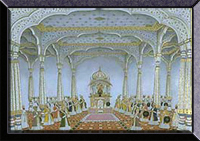 It is indeed true that Hindi and Urdu are descendents of the same
language i.e. Prakrit, but when Hindi was influenced by Sanskrit and
adopted Devanagri script of writing, Urdu absorbed words from Persian,
Turkish and Arabic languages and adopted Persian-Arabic script and
Nastaliq calligraphic style of writing and emerged as a separate language.
In spite of the common ancestry, the two languages are different from each
other in many aspects. There are marked grammatical, phonological and
lexical differences in both languages.
It is indeed true that Hindi and Urdu are descendents of the same
language i.e. Prakrit, but when Hindi was influenced by Sanskrit and
adopted Devanagri script of writing, Urdu absorbed words from Persian,
Turkish and Arabic languages and adopted Persian-Arabic script and
Nastaliq calligraphic style of writing and emerged as a separate language.
In spite of the common ancestry, the two languages are different from each
other in many aspects. There are marked grammatical, phonological and
lexical differences in both languages.
 Urdu Dialects
Urdu Dialects Urdu has four recognized dialects, Dakhini, Pinjari, Rekhta, and Modern Vernacular Urdu. Modern Vernacular Urdu is the form of the language that is most widespread and is spoken around Delhi, Lucknow, Karachi and Lahore. Dakhini (also known as Dakani, Deccani, Desia, Mirgan) is spoken in Maharashtra state in India and around Hyderabad. It has fewer more Persian and Arabic words than standard Urdu. Rekhta (or Rekhti), the language of Urdu poetry, is sometimes counted as a separate dialect.
 Urdu Script
Urdu Script Urdu uses the Arabic script with extensions. A number of the extensions are based on those developed for Persian (Farsi). The basic alphabet covers a much wider repertoire of sounds than found in Arabic, so several extensions have been added to the basic Arabic script. Many of these come via Persian. Like Semitic Languages, Urdu script is written from right to left.
 Vocabulary
Vocabulary 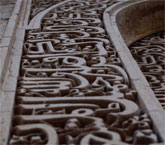 Urdu has a vocabulary rich in words with Indian and Middle Eastern
origins. The borrowings are dominated by words from Persian, and Arabic.
There are also a number of borrowings from Sanskrit, Turkish, Portuguese
and more recently English.
Urdu has a vocabulary rich in words with Indian and Middle Eastern
origins. The borrowings are dominated by words from Persian, and Arabic.
There are also a number of borrowings from Sanskrit, Turkish, Portuguese
and more recently English.Many of the words of Arabic origin have different nuances of meaning and usage than they do in Arabic.
 Literature
Literature 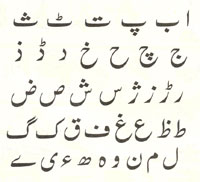 The origin of Urdu literature dates back to the 13th century in India
during the Mughal rule. One of the most eminent earliest poets who made
usage of Urdu in his poetry is Amir Khusro who can be called the father
of Urdu language. In literature, Urdu was usually used along side Persian.
Mughal kings were the great patrons of art and literature and it was under
their rule that Urdu language reached its zenith. There used to be a tradition
of 'Sheri Mehfils' (poetic gatherings) in the kings' courts. Abul Fazal Faizi
and Abdul Rahim Khankhana were the famous Urdu poets of Mughal court.
Likewise, Mirza Ghalib, Allama Iqbal, Hakim Momin, Ibrahim Zauq, Mir
Taqi Mir, Sauda, Ibn-e-Insha and Faiz Ahmed Faiz have contributed to the
evolution of Urdu language through their literary works.
The origin of Urdu literature dates back to the 13th century in India
during the Mughal rule. One of the most eminent earliest poets who made
usage of Urdu in his poetry is Amir Khusro who can be called the father
of Urdu language. In literature, Urdu was usually used along side Persian.
Mughal kings were the great patrons of art and literature and it was under
their rule that Urdu language reached its zenith. There used to be a tradition
of 'Sheri Mehfils' (poetic gatherings) in the kings' courts. Abul Fazal Faizi
and Abdul Rahim Khankhana were the famous Urdu poets of Mughal court.
Likewise, Mirza Ghalib, Allama Iqbal, Hakim Momin, Ibrahim Zauq, Mir
Taqi Mir, Sauda, Ibn-e-Insha and Faiz Ahmed Faiz have contributed to the
evolution of Urdu language through their literary works.
Urdu was also used as a tool by the Muslims for freedom struggle and for creating awareness among Muslim communities in South Asia to unite under the banner of Independence from British Raj. For this, services of Maulana Hali, Sir Syed Ahmed Khan and Allama Iqbal are notable, who through their poetry and prose provoked the necessary spark in the minds of the Muslims.
The following are the famous Personalities of India in Urdu Literature:
Maulana Abul Kalam Azad (1888-1958), one of the prominent Indian National leaders, was an eminent Urdu writer with a philosophical bend. Ali Sardar Jafri (b.1913) is one of the most prolific writers in Urdu. He was born on November 29, 1913, in Ballarpur town of Uttar Pradesh. One of the foremost among the Urdu poets, Faiz Ahmed Faiz (1911-1984) is ranked next only to Ghalib, Mir, Firaq and Iqbal. Firaq Gorakhpuri (1896-1982), whose real name was Raghupati Sahai, was one of the major Indian poets of this century. A crusader for the rights of women and the downtrodden, Ismat Chughtai (1915-1991) was a leading fiction writer in Urdu. Born in a village in Medak, a district of the former princely state of Hyderabad, Makhdoom Mohiuddin (1908-1969) grew up to become a poet of incredible versatility. Mirza Asadullah Khan Ghalib (1797-1869) was the greatest of all the classical Urdu poets. His Diwan-e-Ghalib (1847) is a masterpiece in Urdu literature.
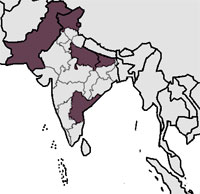 Mirza Mohammad Hadi Ruswa, one of the pioneers of
modern Urdu novel, Ruswa (1858-1931) is best remembered for his Umrao
Jan Ada, a novel about a courtesan living in Oudh before it was annexed by
the British. Mohammed Iqbal (1877-1938) was born at Sialkot (Punjab,
Pakistan) on 22nd February 1873. Iqbal obtained a Ph.D from Munich
for his work on the metaphysics of Persia. Premchand (1880-1936) was a
prolific writer, who wrote some 12 novels and 300 short stories. He tried to
introduce the trend of realism in Urdu novel. A trendsetter in Urdu fiction,
Qurratulain Hyder (b.1927) tried to bring in fantasy, romance and realism
in Urdu novel. Saadat Hasan Manto, a member of the Progressive Writers'
Movement which swept through Urdu literature from 1935 to 1960, Manto
(1912-55) was a very controversial figure in the Urdu field.
Mirza Mohammad Hadi Ruswa, one of the pioneers of
modern Urdu novel, Ruswa (1858-1931) is best remembered for his Umrao
Jan Ada, a novel about a courtesan living in Oudh before it was annexed by
the British. Mohammed Iqbal (1877-1938) was born at Sialkot (Punjab,
Pakistan) on 22nd February 1873. Iqbal obtained a Ph.D from Munich
for his work on the metaphysics of Persia. Premchand (1880-1936) was a
prolific writer, who wrote some 12 novels and 300 short stories. He tried to
introduce the trend of realism in Urdu novel. A trendsetter in Urdu fiction,
Qurratulain Hyder (b.1927) tried to bring in fantasy, romance and realism
in Urdu novel. Saadat Hasan Manto, a member of the Progressive Writers'
Movement which swept through Urdu literature from 1935 to 1960, Manto
(1912-55) was a very controversial figure in the Urdu field. 

